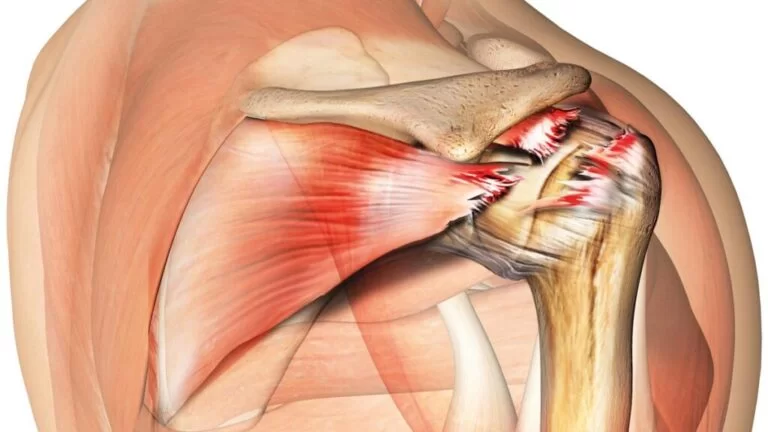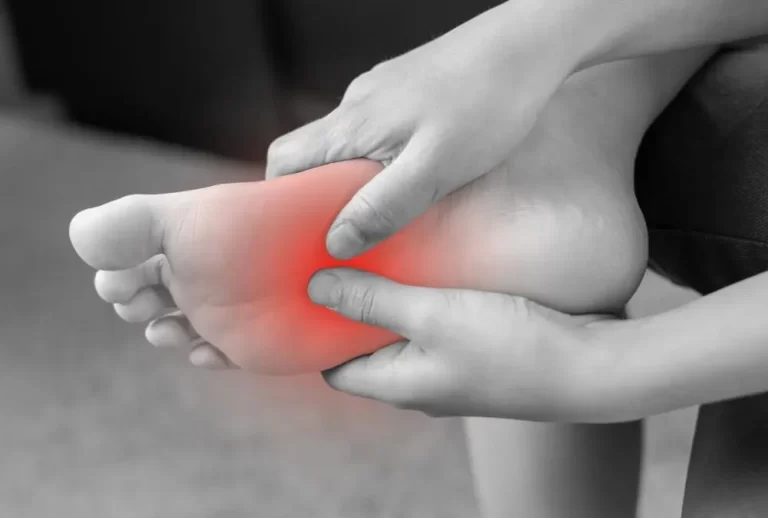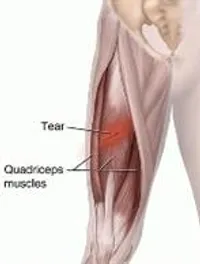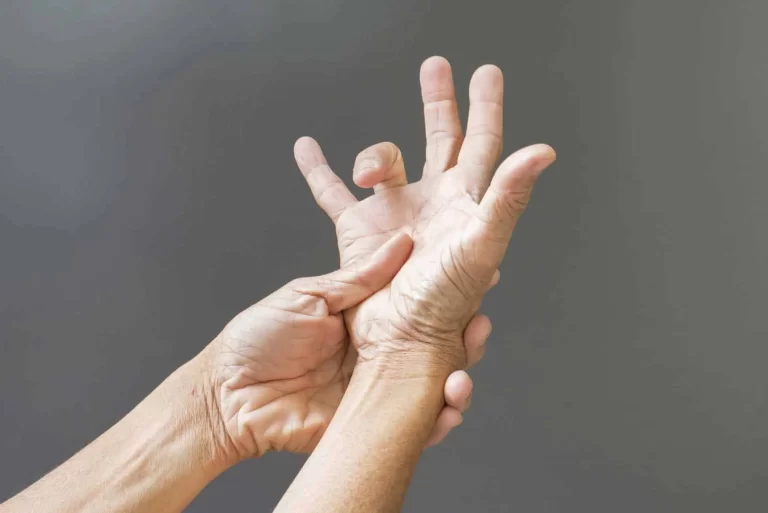Infraspinatus Tendon Tear
Introduction
The infraspinatus tendon tear is a shoulder injury affecting the infraspinatus muscle, one of the four muscles that make up the rotator cuff. This muscle plays a vital role in shoulder stability and allows for the external rotation of the arm.
Tears in the infraspinatus tendon can occur due to acute trauma, such as a fall or sports injury, or from degenerative changes over time, especially in older adults. It can be partial or complete.
Traumatic injuries including falls or direct blows to the shoulder, as well as prolonged repetitive strain on the shoulder joint, can result in an infraspinatus tendon tear. Pain, weakness, restricted range of motion, and swelling or bruises around the shoulder joint are all signs of an infraspinatus tendon injury.
The Infraspinatus muscle: what is it?
- The infraspinatus muscle is an in-thickness trapezoidal muscle located on the back of the shoulder blade or scapula.
- Rotator cuff: The following comprises four muscles that stabilize the shoulder joint.
The Infraspinatus Muscle’s Origin?
The following structures are the source of the infraspinatus muscle:
- The infraspinous fossa is the scapula’s main origin, taking up most of its surface.
- Infraspinous fascia refers to the layer of connective tissue that envelops the muscle and guides its development.
Infraspinatus Muscle Insertion?
Two main structures are where the infraspinatus muscle inserts:
- The primary attachment point that gives the shoulder its mechanical advantage for external rotation is the middle facet of the larger tubercle of the humerus.
- The shoulder joint’s posterior capsule: This insertion aids in joint stability and guards against excessive anterior humeral head translation.
- Together, these attachments enable the infraspinatus muscle to carry out its vital duties of stabilizing the shoulder joint and external rotation.
Source of blood
- The arteries that provide blood to the infraspinatus are the circumflex and suprascapular scapula.
What Does the Infraspinatus Muscle Do?
The infraspinatus muscle’s main purposes are:
- The shoulder’s primary purpose is external rotation. When you reach behind your back or wind up for a backhand tennis stroke, for example, it enables you to rotate your arm outward.
- Shoulder Joint Stabilization: By keeping the humerus’ head firmly in the glenoid cavity, the infraspinatus, a component of the rotator cuff, aids in shoulder joint stabilization. This offers general stability and guards against dislocation during a range of arm motions.
Reasons for tears in the infraspinatus tendon:
There are several reasons why an infraspinatus tendon tear could happen, including:
- Traumatic injury: An infraspinatus tendon tear may result after a fall or a direct hit to the shoulder.
- Repetitive strain: Over time, repetitive overhead motions, like those made when swimming, throwing a ball, or lifting weights, can result in overuse injuries and tendon tears.
- Age-related degeneration: An infraspinatus tendon tear may become more likely as we age because our tendons lose some of their elasticity and become more prone to degeneration.
- Bad posture: Bad posture, including spending a lot of time stooped over a computer, can strain the shoulder joint and cause a tendon tear.
- Shoulder muscle weakness or imbalance: Overuse injuries and a higher risk of tendon tears can result from weakness or imbalance in the muscles supporting the shoulder joint.
- Some medical disorders: Rheumatoid arthritis and diabetes are two examples of conditions that can weaken tendons and raise the risk of tearing them.
To stop additional damage and encourage appropriate healing, it’s critical to determine and treat the underlying cause of an infraspinatus tendon tear.
Signs of an infraspinatus tendon break:
Depending on how severe the damage is, an infraspinatus tendon tear might present with a variety of symptoms. Typical symptoms include the following:
- Shoulder weakness, especially when lifting or reaching upwards;
- discomfort or pain in the shoulder’s back;
- restricted shoulder joint range of motion;
- a sound that pops or clicks as the shoulder joint is moved;
- Swelling and redness surrounding the affected shoulder
Diagnosis of Infraspinatus tendon Tear:
Seeing a specialist is crucial for a correct diagnosis if you are exhibiting signs of an infraspinatus tendon tear. The following are some typical techniques for identifying a tear in the infraspinatus tendon:
Physical examination: To check for pain, weakness, or restricted range of motion, your doctor will probably start with a physical examination, which may involve rotating your shoulder in various directions. To feel for soreness, they could also apply pressure to various areas of your shoulder.
A unique examination for the infraspinatus tendon
During a physical examination, several specialized tests can be used to assist in detecting an infraspinatus tendon injury. The following are a few of the most popular specialized tests for shoulder injuries:
Drop arm test: This straightforward and accurate examination can identify rotator cuff tears, including tears in the infraspinatus tendon. The patient extends their arm to shoulder level and then gradually lowers it to their side during the exam. An abrupt lowering of the arm may indicate a rotator cuff tear, involving the infraspinatus tendon.
External Rotation Lag Sign: The patient is asked to place their arm at their side, palm up, elbow bent to a 90-degree angle, to do this test. The patient is then asked to externally rotate their arm while restraining themselves from the examiner’s pressure while the examiner holds their wrist. The inability of the patient to maintain the position may be a sign of an infraspinatus tendon injury.
During the infraspinatus test, the patient’s arm is held at the side with the elbow bent to a 90-degree angle and the palm facing down. After that, the patient tries to externally rotate their arm as the tester applies pressure to the back of their hand. An infraspinatus tendon tear may be indicated by test-related pain or weakness.
The Hornblower’s Sign exam involves having the patient place their arm at their side with the palm facing down and the elbow bent to a 90-degree angle. The examiner next gives the patient instructions to internally rotate their arm against resistance. An infraspinatus tendon tear may be indicated by the inability to execute this movement.
Imaging studies: Any structural abnormalities, including a tear in the infraspinatus tendon, can be detected with the use of imaging tests like X-rays, MRIs (Magnetic Resonance Imaging), or ultrasounds. Your doctor can assess the extent of the injury with the use of these tests, which can give a thorough picture of the shoulder joint.
Electromyography (EMG): The electrical activity of the shoulder’s muscles and nerves can be assessed using an EMG test, which can assist assess the degree of injury and the health of the muscles.
Diagnostic injection: To ascertain whether the infraspinatus tendon or another part of the shoulder is causing the pain, a diagnostic injection of a local anesthetic into the shoulder joint can be helpful.
Infraspinatus tendon tear treatment:
The severity of the tear will determine how the infraspinatus tendon is treated. Non-surgical therapy alternatives could be suggested for minor tears. If the tears are more severe, surgery may be necessary.
Non-Surgical Therapy
Applying ice to the affected area and resting the shoulder can help reduce discomfort and inflammation.
Physical therapy: Physical treatment helps enhance shoulder stability and strengthen shoulder muscles. An exercise regimen customized for your particular condition might be developed by a physical therapist.
Medication: To control pain and lower inflammation, doctors may prescribe nonsteroidal anti-inflammatory medicines (NSAIDs) or over-the-counter pain relievers such as acetaminophen.
Corticosteroid Injection: To lessen shoulder pain and inflammation, a corticosteroid injection might be suggested. These injections should be used carefully, though, as they have the potential to weaken the tendon and raise the risk of more damage.
Surgical Intervention
For more severe tears of the infraspinatus tendon, surgery could be advised. The type of surgery performed will depend on the location and size of the tear. Typical surgical techniques consist of:
Arthroscopic Surgery: This minimally invasive procedure repairs the tendon by making tiny incisions in the shoulder and utilizing a camera and tiny tools.
To quickly access the injured tendon, open surgery entails making a wider incision in the shoulder.
Tendon Transfer: In certain situations, the torn infraspinatus tendon may be replaced by a tendon from another area of the body.
To guarantee appropriate healing and recovery following surgery, a period of rest and physical therapy is required.
Physiotherapy for a tear in the infraspinatus tendon:
For an infraspinatus tendon tear, phase-wise physiotherapy management usually entails a progressive approach to rehabilitation with an emphasis on pain management, inflammatory control, and a gradual return to shoulder function. The following are the usual stages of physiotherapy for a tear in the infraspinatus tendon:
Phase 1: The Acute Stage
The goals of this stage are to keep the shoulder joint mobile, prevent more damage, and lessen pain and inflammation. Rest, ultrasound, cold or heat therapy, and mild range-of-motion exercises are some possible forms of treatment.
A pendulum
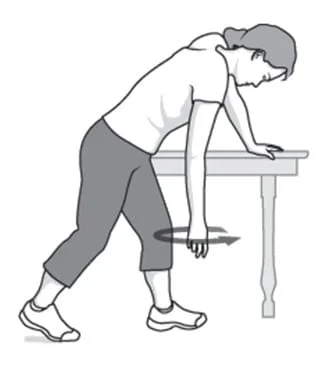
To prevent a frozen shoulder, this exercise helps lengthen your muscles and the area they travel through.
- At an angle, lean forward. Support yourself with your unaffected arm.
- Move those affected arms back and forth and side to side with caution.
- After that, move it in little circles.
- Perform two sets of ten each.
Phase 2: The Subacute Stage
Regaining shoulder range of motion, enhancing shoulder blade control, and strengthening the rotator cuff muscles are all part of this phase. Exercises for range of motion, shoulder blade stabilization, and isometric strengthening may all be part of the treatment.
Isometric external rotation
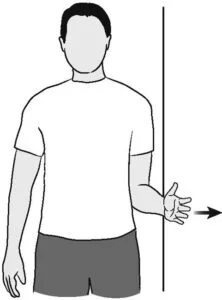
Training using effort-based isometric contractions is done against a wall. Elevate those elbows at a 90-degree tilt while you’re positioned close to a wall. Make certain that your elbow is up straight and just beneath your shoulder. Over three seconds, steadily build your strength by pressing outward against the wall with your thumb up. Before gradually reducing your strength to rest (again over a count of three seconds), maintain your maximum allowable contraction for five to seven seconds.
Phase 3: Phase of Strengthening
The primary objective of this phase is to increase the endurance as well as strength of the shoulder blade, rotator cuff, and other shoulder muscles. Resistance training activities like scapular retraction, shoulder abduction with weights, and external rotation with a resistance band may be part of the treatment.
lateral external rotations
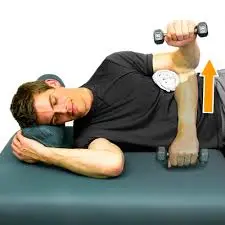
This workout focuses on the external rotators of the shoulder, which strengthen the rotator cuff. Hold a dumbbell in your upper arm while you’re on your side. Maintain the elbow tucked in on your side as you increase the weight into maximal external rotation (within reasonable bounds). Continue lowering the weight gradually until it is in front of your abdomen.
Eccentric external rotation of the shoulder
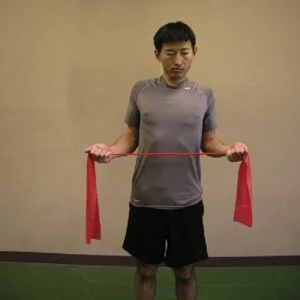
This workout uses a band to provide resistance to the rotator cuff muscles. While clutching the band, maintain your elbows curled in just behind your shoulder and both of your hands pointed up. Rotate your external arm as much as you can manage, then gently return to the beginning position over five to seven seconds.
Phase 4: Get Back to Work
During this stage, functional activities and sports-specific motions are gradually resumed. Sport-specific training and exercises that mimic the demands of the patient’s sport or activity may be part of the treatment.
It is significant to remember that the length of time and course of each physiotherapy care phase could vary based on the age, health, and extent of the infraspinatus tendon tear. Throughout each stage of rehabilitation, a physiotherapist can assist in creating a customized therapy plan and tracking advancement.
How Can an Infraspinatus Tendon Tear Be Prevented?
Taking precautions to preserve shoulder health and reduce the chance of damage is necessary to avoid an infraspinatus tendon tear. Among the successful preventative techniques are:
- Warming up before physical activity; doing regular shoulder strengthening exercises;
- maintaining proper posture and shoulder mechanics throughout activities.
- Steering clear of repetitive motions and overuse
- Paying attention to the body and taking rests when needed
Conclusion
Although an infraspinatus tendon tear can be an excruciating and incapacitating injury, people can heal and resume their regular activities with the right diagnosis and care. An infraspinatus tendon tear can also be prevented by taking preventive steps, such as keeping your shoulders healthy and utilizing good form when you’re doing things.
FAQs
Is it possible for an infraspinatus tear to repair itself?
Although rotator cuff tears cannot be repaired without surgery, many patients can reduce pain and improve function with nonsurgical shoulder muscle training.
What would happen if your infraspinatus were to tear?
Overhead athletes, overuse injuries, and persistent shoulder instability are common causes of infraspinatus tendon tears. The primary complaints are weakness in the affected arm, pain during sleep, and difficulty moving the arm in specific ways.
How is an infraspinatus tear diagnosed?
The patient is directed to externally rotate both forearms against the examiner’s wishes. When external rotation is painful or fragile, the test is considered favorable. External rotation weakness strongly signals an infraspinatus tear because these tears are typically painless.
Is it possible to recover completely from a shoulder tear?
It can take four to six weeks to recover completely from a mild rip with the right rest and recuperation. Tears may never heal on their own if they are more severe or if they are not properly treated.
What causes the tightness in the infraspinatus?
Most likely as a result of our significant shoulder stress and heavy hand usage.
Are shoulder tears irreversible?
Untreated rotator cuff tears can result in irreversible damage, perhaps preventing shoulder mobility.
References
- Hirpara, D. (2023, December 13). Infraspinatus muscle – Origin, Insertion, Function, Exercise. Mobile Physiotherapy Clinic. https://mobilephysiotherapyclinic.in/infraspinatus-muscle/
- Vaghela, M. (2023c, March 21). Infraspinatus tendon tear – Cause, Symptoms, Treatment. Samarpan Physiotherapy Clinic. https://samarpanphysioclinic.com/infraspinatus-tendon-tear/
- Ladva, V. (2023, July 8). Special test for the Infraspinatus Tear/ Bicipital Tendinitis. Mobile Physiotherapy Clinic. https://mobilephysiotherapyclinic.in/special-test-for-the-infraspinatus-tear-bicipital-tendinitis/

